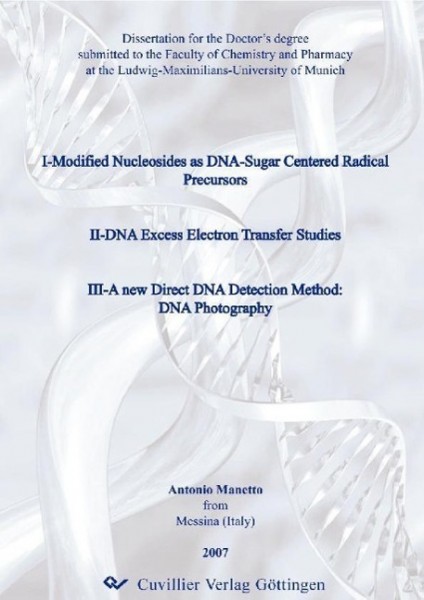I-Modified Nucleosides as DNA-Sugar Centered Radical Precursors II-DNA Excess Electron Transfer Stud
Kurzinformation

Beschreibung
During cellular metabolism of oxygen to water in the mithocondria, a small fraction of the oxygen is reductively converted into superoxide (O2¿-) as a by product. Through complex biochemical processes, superoxide may be converted into various reactive oxygen species (ROS), e.g. hydroxyl radicals (¿OH), H2O2, 1O2, etc. These ROS and in particular the highly diffusible ¿OH are known to cause chemical modifications on DNA through the formation of strand breaks and nucleobase modifications. DNA damage and strand breaks may also be induced through other environmental influences such as ionizing radiation, photooxidation and naturally occurring or synthetic chemical mutagens. Oxidative DNA damage can be produced by the oxidation of the nucleobases or of the sugar units. In the last case carbon centered radicals are formed by direct or indirect hydrogen abstraction. In the first part of this thesis (Chapter 1), the fate of the carbon centered radicals C5' and pseudo C4' of the sugar was investigated at the nucleoside level. The syntheses of new thermal or photolabile C5' and pseudo C4' radical precursors were achieved to this end and the mechanistic aspects were studied under various conditions. Kinetic data were obtained as well and the access to biological lesions was possible through these studies. In section 1.2.1, the synthesis of a novel perester radical precursor was achieved. The unprecedented selective generation of the pseudo C4' radical was established as well. The radical was studied in solution under various conditions and the pathways of base releasing and degradation were proved and described.In section 1.2.2 a short and efficient synthetic sequence for the preparation of cyclonucleosides has been disclosed, based on consecutive radical reactions followed by a photochemical desilylation. The C5' radicals, generated by the addition of a (TMS)3Si¿ radical to the corresponding 5' carboxaldehyde, are the key intermediates in these transformations. The rate constant kC of the subsequent cyclisation reaction was estimated for the first time in such systems through a radical clock reaction setup. The value of kC = 7 × 103 s 1 at 25 °C found here is strictly correlated with the C5' radical repair reaction.In section 1.2.3 a new synthetic route for the preparation of (5'R) tert butyl ketones was disclosed. Photolysis experiments selectively afforded the corresponding C5' radical. In the presence of a physiological concentration of alkanethiol, the thymidin 5' yl radical is efficiently reduced. Under these conditions the half life of the thymidin 5' yl radical was calculated to be t1/2 = 6.6 min. without any cyclisation product being observed. The resulting C5' radical could be obtained either by Norrish Type I photocleavage or by initial formation of an acyl radical that decarbonylates with a rate constant in the range of 105-106 s-1. The presence of a thiol prevents subsequent reactions such as the intramolecular attack onto the C6-C5 double bond of thymine.
Produktdetails

So garantieren wir Dir zu jeder Zeit Premiumqualität.






 bestellen
bestellen



